American Sabbatical 68: 3/11/97
St. Mary's City
3/11... chasing the Virgin.
Monday night had come off lowery with sprinkles, but Tuesday morn smiled again and brushed us
with a warm hand. Going SOUTH is different from heading WEST.
Out that way you climb through dramatic changes, feel an opening
out.. and you are chasing the old American Dream. Going this way
the changes are more subtle, there is a thickening of the air..
and you’re sinking into the American Subconscious.
The South is the dark place in our national psychology. We got
two kinds of messages from friends about going south: you are
going to love it, the people will overwhelm you.. or: watch out,
it’s dangerous down there. This is the storied land of Momma and
Deliverance. That drawl is the voice of midnight stories.
So my ears were cocked for traces of deep dialect, full of mystery
and romance. And I'd looked forward to driving through some transparent
barrier into floral fragrances, skin-tingling rays, and riotous
pastels: SPRING. Maybe in southern Georgia, or FLA. What I’d forgotten
is that spring is a progression of gentle hints and promises.
More like a waltz than a slam dance.. a courting ritual. Is it
the first daffs, or forsythia? Leaves breaking out, or the songbirds
returning? Every day we encounter more and more signs, but the
deep woods are still stark and bare, and the breeze has an edge.
One minute we’re cruising in our shirtsleeves with the windows
down, the next we’re all bundled up wondering why we left our
longjohns home. I guess that’s like spring in Maine, Huh?
Tuesday morning Peggy had to swallow one plantation before breakfast,
so we perused George Mason’s, which was hard by the EconoLodge.
You can’t move down here by the Potomac without bumping into an
historic marker, and you could easily spend a month touring colonial
era and civil war sites. We settled for Gunston Hall.
(Memo #57)
March 11 George Mason - Gunston Hall
Who? radical revolutionary leader
What? author of first Bill of Rights
Where? Virginia planter, neighbor / friend of George Washington
When? before and during Revolution
How? wrote, spoke, lobbied for individual rights
Topics: Bill of Rights, Revolution, revolutionary leaders
Questions: Why isn’t George Mason better known? Why was he considered
a radical? |
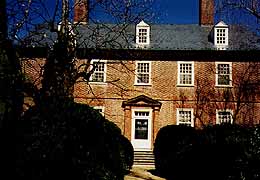
Gunston Hall
|
The Virginia Bill of Rights (included in the state’s 1776 Constitution)
laid out the individual and natural rights that its chief author,
George Mason of Gunston Hall, Virginia, thought were crucial.
His eloquence and reasoning lead his friend Thomas Jefferson to
use passages from the Virginia document in the Declaration of
Independence. The first ten amendments to the U.S. Constitution
(our national Bill of Rights) show Mason’s influence as well.
He lobbied long and hard for these guarantees of personal liberty,
for religious tolerance, for trial by jury. Mason was active in
the tense period before the Revolution in Virginia. He brainstormed
the 1760’s boycotts of English goods, authoring the Non-Importation
Resolutions of Virginia. He gets credited by some people for the
French constitutional guarantees of rights and the UN Charter.
Just before the recent reunification of Germany, German legislator
came to Virginia to study the writings of George Mason (!).
Why then is Mason relatively unknown, eclipsed by his neighbor
and friend George Washington and the other Revolutionary leaders
(Madison, Henry, Adams, Jefferson)? Mason was a radical, unwilling
to compromise for the sake of political necessity. He was eloquent
and well-read, a “man of the first order of wisdom” according
to Thomas Jefferson. He went to the Constitutional Convention
in 1787 and was once of the most active delegates there, speaking
over 136 times and writing 18 objections. He had two main causes
- personal liberties and an end to the slave trade. At the end
of the long hot summer he took the stand that a Constitution without
a Bill of Rights and one that allowed the trade in humans (though
the slave trade was - according to the Constitution - to end in
1808) was wrong... and he refused to sign the document laboriously
hammered out in Philadelphia. He was one of three delegates not
to sign. George Washington, his neighbor and longtime friend,
never forgave him. Mason was never invited to nearby Mt. Vernon
again and was referred to as “my former friend.”
I went to Gunston Hall to get a better sense of this man who would
risk his dearest friendships for principle. Perhaps ten miles
south of Mount Vernon, a mile inland from the Potomac, Mason's
abode is a brick house at the end of a long beautiful avenue of
magnolia trees. The house is modest in size when compared to other
plantations, but richly decorated. It must have been stuffed to
the eaves by Mason’s twelve children, paid employees, indentured
servants, and slaves. A lovely formal garden with extensive boxwood
allees stretch toward the river with a smaller formal garden below
it and a deer park between the two and the river.
Once again I was forced to question historical reconstruction.
Gunston Hall was a contrast to Mt. Vernon where so many of the
furnishings actually belonged to Martha and George and the rooms
are know from period prints and drawings. At Gunston Hall we heard
the phrases “from the era”, “much like the ones that would have
been used”, and “typical of the period”. Few of the furnishings
had actually belonged to George Mason (I asked). But, then, the
house Mason had designed was lived in and renovated by his descendants.
And he was not seen as significant enough to enshrine.
We saw reconstruction in progress. It was fascinating to see the
“ghost” shapes of the earliest molding or pediments uncovered
on the original walls and hear how the staff recreated the original
wallpaper (the earliest Chinese wallpaper in the US) from fragments,
used 18th century paint formulas, and uncovered the back stairway
(still to be reconstructed). Four rooms open off the great central
hall, two on either side. A master bedroom and study on one side,
the dining room and formal parlor on the other. Upstairs there
are five bedrooms and a box room. The treasure of this plantation
house is the wooden carving - arches and trim and details and
fireplace surrounds in intricate beautiful detailed carving, the
work of an indentured servant named William Buckland whose reward
was "meat, drink, washing, lodging and twenty pounds a year" for
four years.
Gunston Hall was once a 5500 acre plantation producing tobacco
and wheat for sale. It had its own landing on the Potomac. At
one time there were 30 outbuildings. Six remain. I toured the
cookhouse, washhouse, smokehouse, and schoolhouse. The specialists
may have lived above their workshops in each case. Little is know
about the Gunston Hall workforce. Mason apparently mentioned 45
slaves by name in his will and had perhaps 90 at Gunston Hall.
The guide said he had a large number of paid and indentured workers
too.
There is a museum nearby that displays Mason family artifacts
and historical items - the horticulture books used by the Virginia
farmers and the pew rental agreement signed by Washington and
Mason.
It is a beautiful house and garden, but I did not get a full sense
of the plantation enterprise, nor of the fascinating man who lived
there.
“All men are born equally free and independent and have certain
inherent rights”
- George Mason
3/11.. cont.
A bald eagle swooped low over Gunston Hall as I waited for the teacher to finish her snack.
The docents told me there are now paddlewheel boat trips up the
Rappahannock to see eagles nesting. She said there were three
pairs doing their courting spiral over the Potomac yesterday.
One was enough to cheer me.
We made wingbeats out onto Rt.1 again, but my attempts to cross
some degrees of latitude didn’t make it past teacher’s cheat-sheet.
Peggy has refined her navigation to a science, and she has a library
of guides, maps and encyclopedia at her fingertips. She had been
muttering about St. Mary’s City, the first Catholic settlement,
over on the Maryland shore, and my attempts to dodge the crossing
were futile. Turn here, she said.
I’m glad we did. The dogwoods lining downtown Fredericksburg are
in full bloom, and couples were sipping coffee at an outdoor cafe
on the brick sidewalk. All along the tidewater back roads ornamental
plantings are exploding in pinks, and whites, and lavender, and
forsythia is shouting. Even the fresh orange cutbanks at building
sites seemed jovial.
Down all these Chesapeake fingers there’s a discordant mix of
rundown agriculture and elegant gentleman estates, beater bungalows
and gated condo developments. I have to wonder if the US and THEM
thing is torquing the social order here the way it has in coastal
Maine, or does the old hierarchies simply perpetuate themselves..
Massa? Today, with the willows weeping pale green, and the new
grass so virulent it almost hurts, it’s hard to imagine any hostility
churning these waters.
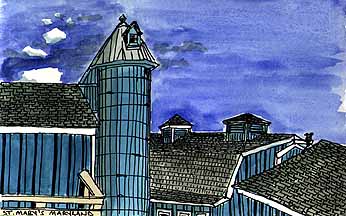
Blue Barns at St. Mary's City
We ran through aisles of tidewater piney woods and tall hardwood
groves, meandered across wide agricultural flats with lines of
green shoots sprouting, and past winter meadows where the old
straw was a glowing russet against the graying sky. Coming down
to the shore at St. Mary’s City the mouth of the river was chopping
up white across the blue-gray waters.
(Memo #58)
March 11 St. Mary’s City - Religious Freedom
Who? first settlers of Maryland, Catholics in colonial America
What? Catholic immigrants from England
Where? colony on small bay near mouth of Potomac River
When? 1634
How? Lord Calvert given right by king to start a Catholic refuge
Topics: religious freedom, Toleration Act, colonization of Maryland
Questions: What does freedom of religion mean? How has it been
interpreted and extended in United States history? |
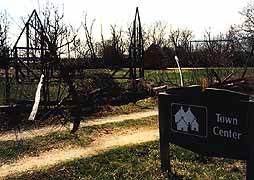
St. Mary's
|
High school students always state that the Puritans (Boston) and
Pilgrims (Plimoth - original spelling) came to this country for
religious freedom. This is true, but not our modern concept of
religious freedom. Today you are free to practice any religion
or none in the USA. In Massachusetts Bay Colony or Plimoth in
the 1600’s you were free to be LIKE THEM, free to be only a single
distinctive type of Protestant.
This New England Protestantism WAS a step in the development of
religious freedom since Pilgrims and Puritans had been persecuted
in England. They were free in New England to practice their own
brand of Protestantism, but Catholics, Quakers, Jews were not
allowed in either colony. There are records, for example, of Quakers
being branded and expelled from Boston.
Roger Williams, a minister, and Anne Hutchinson were thrown out
of Massachusetts for daring to interpret the Bible their own ways.
These two radicals were simply following the ideas that had started
the Reformation: the INDIVIDUAL could read and interpret the Bible,
it was not necessary to have a hierarchy of churchmen clarifying
dogma. Freedom of religion in the United States is very much tied
to freedom of the press and to free public education and to the
separation of church and state, and to individualism. Press to
provide books and Bibles, education so you can read, separation
so that public money is not spent on church affairs. Yet the establishment
of our contemporary freedom of religion came slowly.
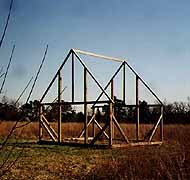
Museum Skeleton
|
It all happened in small steady steps. Quakers settled Pennsylvania
and allowed any form of monotheism in their colony. Roger Williams
went to the ultimate extreme and created a colony (Rhode Island)
where you were free to worship according to the dictates of your
conscience (logically, the first US synagogue was in Newport).
George Mason was part of the Virginia debate as to whether clergymen
should continue to be paid by the government. The religious test
for voting was ended by the time of the Revolution (colonial men
could not vote unless they were rich AND in good standing with
the church).
|
St. Mary’s City was the beginning of the state of Maryland and
the first English colony where Catholics were welcomed. (Remember
the struggle in England between Roundheads and Cavaliers, between
Mary the Catholic Queen and her sister Elizabeth the Protestant
one?)
St. Mary’s City did not become part of a modern metropolis. The
Maryland capital moved and the site eventually fell into ruin.
The small College of St. Mary’s lies adjacent to the site, beautiful
pastures and woods overlooking a small bay. It is about two hours
southeast of Washington D.C. on a peninsula that juts out into
Chesapeake Bay north of the mouth of the Potomac.
The site was not officially open which is a mixed blessing. The
paths are empty of tourists and we could wander at will. The few
complete building (the first capitol, the tavern, a house), however,
were not open and there was no official literature available.
Still it was lovely. The trees were budding and there were clumps
of daffodils here and there.
The staff has opted for accuracy. Since they only know what the
foundation of the Catholic church was like, they have created
a framework of timbers, not a full building. The structure looms
empty against the sky. A sign tells you of the many lost graves
nearby marked by wooden crosses that rotted. Each house site has
a frame of a building. There are many signs as you walk through
the village orienting you to the original roads and buildings.
A small ship is moored to the dock. A gazebo and garden are dedicated
to Margaret Brent, a woman basically left in charge of the colony
by the Governor at one point who fought (unsuccessfully) to be
accepted as a woman leader.
The peaceful site does not show the colony’s drama, the continuing
fight for religious tolerance and power. In 1949 The Maryland
Toleration Act guaranteed freedom of conscience to anyone believing
in Jesus Christ (i.e. all Christians). The colony was legally
more tolerant of religious differences than Mass. Bay or Plimoth,
less tolerant than Pennsylvania or Rhode Island. Even limited
tolerance was under constant attack. Protestants seized control
of the colony in 1654 and made “Popery or Prelacy” a crime. The
struggle continued, focused more on power and control of colonial
matters than religion. The precedent remained.
| Catholics had later struggles in the United States. The great
wave of Irish immigration in the 1840’s caused by the potato blight
and widespread famine was met by prejudice and discrimination.
“No Catholics or Dogs” read signs in Boston businesses. I remember
in 1960 when John Kennedy was running for President that cartoons
and editorials said he couldn’t be president because the Pope
would run the USA! |
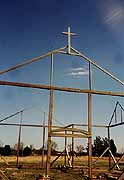
Church Site
|
Today we continue to debate and legally test freedom of religion.
Can student religious groups meet in schools? Can a town finance
Christmas decorations? As America becomes more diverse we will
have other decisions to make. How can a school accommodate the
need of Muslim students to pray during the school day? How can
a Jew go on an airplane and observe kosher eating rules? Why should
stores or business be shut on Sunday when Friday and Saturday
are the holy days for other religions in America? There are endless
points to discuss and debate.
St. Mary’s City is one of the places where religious freedom began.
The empty timber frames of its building are symbolic of the work
still to be done.
3/11.. cont.
After this Catholic interlude, we pushed our daily limit by backtracking to the Potomac crossing
with the sunset in our eyes, and marching on to Ashland, just
outside Richmond. Every signpost was an accusation. The Army of
the Potomac took four years to get this far, watering these woods
with blood, and we were rushing past looking for a cheap motel.
In January I read U.S.Grant’s memoirs, the best presidential autobiography
of them all, and I’d galloped across this terrain with “Sam” Grant,
while he was earning the name of “Butcher.” His book teaches that
he brought history to Appomattox because he was singleminded in
his stubbornness, had a superior sense of grand strategy, forged
a back-channel alliance with Lincoln, and had fighting generals
he could trust. But the cost was horrendous, and so much of the
blood was shed between the Potomac and the James. But we are saving
our Civil War touring for “the West”, where Grant became the man
who could beat Lee. We bivouacked in the Super8 in Ashland.




